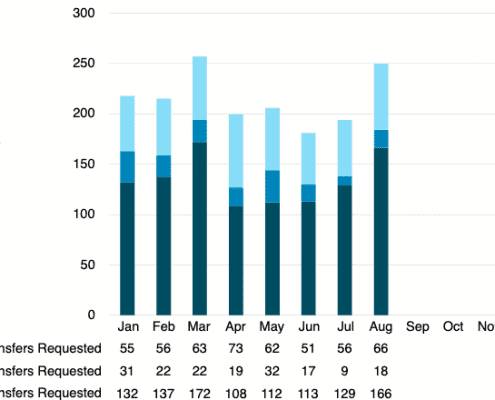Posts

How Does BGP & Internet Routing Registry Affect IPv4?
IPv4 BlogWhat are BGP Routing Records? Border Gateway Protocol (BGP) is a protocol that allows for the fastest and most efficient routing of internet traffic. The owner of an IPv4 Address subnet asks their upstream internet service provider to route specific IPv4 subnets now smaller than a /24 to route traffic using the best method of delivery. BGP is responsible for assessing all of the available internet routes that data can travel and then choose the best option, which usually means hopping between Autonomous Systems (AS) numbers that represent the upstream internet providers network.
Inflations Impact on IPv4 Prices – September 2022
IPv4 BlogWe are finally seeing some good news on the IPv4 demand front. As of September 2022, we have 2 months in a row of positive IPv4 demand trends that parallel previous years, prior to the IPv4 crash in May of 2021. We aren’t out of the woods just yet, however, the indicators could be great for the remainder of the year.

IPv4 Demand Increase – August 2022
IPv4 BlogSo far, 2022 has shown a stable yet low level of IPv4 demand as compared to the previous three years. This is largely attributed to a massive increase in demand and the shortage of IPv4 inventory back in 2021, which in turn caused the prices to increase by 100% in just 1 year.
July IPv4 Address Transfer Trends
IPv4 BlogThe IPv4 transfer market was born when ARIN, RIPE and APNIC created policy to allow IPv4 address to be transferred from one owner to another. According to the transfer logs from the three internet registries, there have been over 360 million IPv4 addresses transferred between private parties since 2016

Rural Digital Opportunity Fund (RDOF)
IPv4 BlogThe Rural Digital Opportunity Fund (RDOF) is a Federal Communications Commission (FCC) initiative designed to inject billions of taxpayer’s money into the construction and operation of rural broadband networks across America. RDOF is a key part of the FCC's efforts to close the digital divide and ensure that all Americans have access to high-speed broadband. The intent of the program is to greatly improve the quality of life for communities in rural areas, while also creating a more connected nation as we move into the future. We will continue to provide updates on this significant initiative as more information becomes available.
 2024
2024How to Choose an IPv4 Broker
IPv4 Blog, Knowledge HubRIPE Provider Aggregatable (PA) & Provider Independent (PI) IPv4 Addresses serve distinct purposes within the internet addressing landscape.

IPv4 Price Stabilization & Comparison – June 2022
IPv4 BlogAs of June 2022, the IPv4 market seems to have created a new IPv4 demand baseline. With only 113 IPv4 transfer requests last month, we have a 3-month average of 111 transfer requests. While this is a steady stream of demand, the rest of the picture paints an interesting story for the end of the year.
Recessions Impact on IPv4 Sales – May 2022
IPv4 BlogThe general consensus amongst many stock market analysts indicate that our economy might be headed into a recession. As seen in past instances, the IPv4 transfer market tends to follow the the global stock market. With the stock market continuing to decline, so do the number of IPv4 transfer requests, which is a strong indicator of the current global IPv4 demand.
Significant IPv4 Demand Volatility in April 2022
IPv4 BlogApril 2022 transfer requests decreased to only 108, demonstrating another massive decrease of -37% as compared to March. When looking at the average of 137 transfer requests in 2022, the decrease is still very significant at -21%. Interestingly enough, the April & Mays average transfer requests are still 140 per month, which does align with what we have found to be the “new IPv4 norm” over the last 11 months.
IPv4 Transfer Swing March 2022 – Are the Bulls Coming?
IPv4 BlogIn March of 2022, the total ARIN transfer requests increased to 172, which demonstrates an increase in demand of over +27% as compared to the previous 10-month average. This swing in transfer requests is timely, as many people were starting to wonder if prices were going to start to fall due to decreased interest and demand for IPv4 addresses globally.